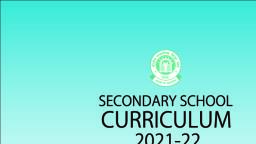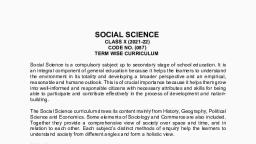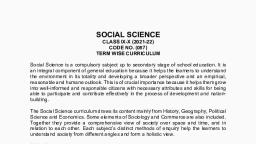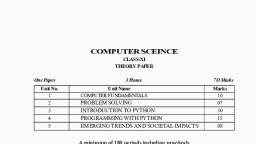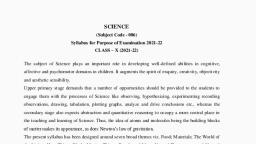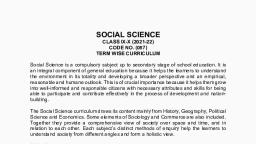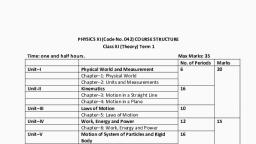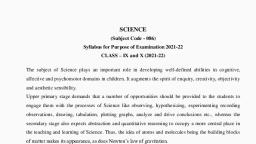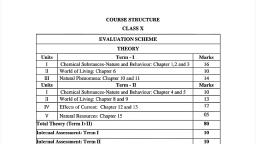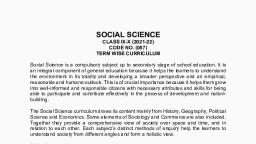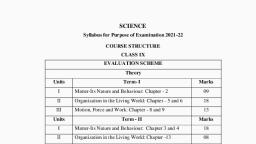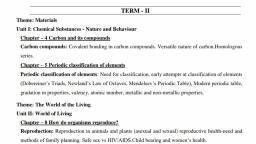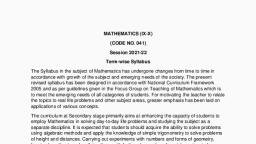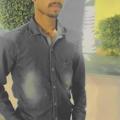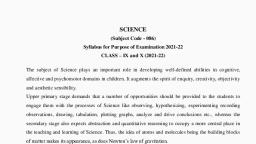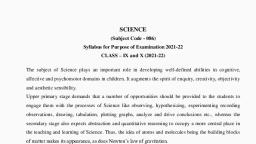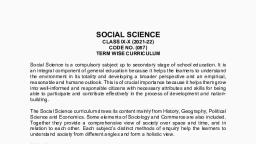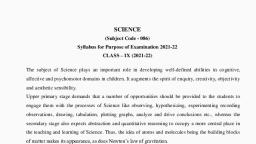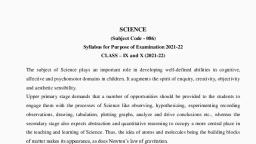Page 1 :
SCIENCE, (Subject Code - 086), Syllabus for Purpose of Examination 2021-22, CLASS – IX and X (2021-22), The subject of Science plays an important role in developing well-defined abilities in cognitive,, affective and psychomotor domains in children. It augments the spirit of enquiry, creativity, objectivity, and aesthetic sensibility., Upper primary stage demands that a number of opportunities should be provided to the students to, engage them with the processes of Science like observing, hypothesizing, experimenting recording, observations, drawing, tabulation, plotting graphs, analyze and drive conclusions etc., whereas the, secondary stage also expects abstraction and quantitative reasoning to occupy a more central place in, the teaching and learning of Science. Thus, the idea of atoms and molecules being the building blocks, of matter makes its appearance, as does Newton’s law of gravitation., The present syllabus has been designed around seven broad themes viz. Food; Materials; The World of, the Living; How Things Work; Moving Things, People and Ideas; Natural Phenomenon and Natural, Resources. Special care has been taken to avoid the temptation of adding too many concepts than can, be comfortably learnt in the given time frame. No attempt has been made to be comprehensive., At this stage, while science is still a common subject, the disciplines of Physics, Chemistry and, Biology begin to emerge. The students should be exposed to experiences based on hands - on activities, as well as modes of reasoning that are typical of the subject., General Instructions:, 1. The total Theory Examinations (Term I+II) will be of 80 marks and 20 marks weightage shall, , be for Internal Assessment (Term I+II)., 2. Internal Assessment - Maximum Marks 10 for each Term:, a. There will be Periodic Assessment that would include:, , , , Three periodic tests will be conducted by the school in the entire session. Average of the, two periodic tests/marks of best periodic Test conducted in the Term is to be taken for, consideration., , , , Diverse methods of assessment as per the need of the class dynamics and curriculum, transaction. These may include - short tests, oral test, quiz, concept maps, projects,, posters, presentations, enquiry based scientific investigations etc., , b. Subject Enrichment in the form of Practical/Laboratory work should be done throughout the, , year and the student should maintain record of the same. Practical Assessment should be, Page 1 of 10
Page 2 :
continuous. All practicals listed in the syllabus must be completed., c. Portfolio to be prepared by the student- This would include classwork and other sample of, , student work., COURSE STRUCTURE, CLASS IX, EVALUATION SCHEME, Theory, Units, , Term- I, , Marks, , I, , Matter-Its Nature and Behaviour: Chapter - 2, , 09, , II, , Organization in the Living World: Chapter - 5 and 6, , 18, , III, , Motion, Force and Work: Chapter - 8 and 9, , 13, , Units, , Term - II, , Marks, , I, , Matter-Its Nature and Behaviour: Chapter 3 and 4, , 18, , II, , Organization in the Living World: Chapter -13, , 08, , III, , Motion, Force and Work: 10 and 11, , 14, , Total Theory (Term I+II), , 80, , Internal Assessment: Term I, , 10, , Internal Assessment: Term II, , 10, , Grand Total, , 100, , TERM – I, Theme: Materials, Unit I: Matter- It’s Nature and Behaviour, Chapter – 2 Is matter around us Pure, Nature of matter: Elements, compounds and mixtures. Heterogeneous and homogenous mixtures,, colloids and suspensions., Theme: The World of the Living, Unit II: Organization in the Living World, Chapter – 5 The Fundamental Unit of Life, Cell - Basic Unit of life: Cell as a basic unit of life; prokaryotic and eukaryotic cells, multicellular, organisms; cell membrane and cell wall, cell organelles and cell inclusions; chloroplast,, mitochondria, vacuoles, endoplasmic reticulum, Golgi apparatus; nucleus, chromosomes - basic, structure, number., Chapter – 6 Tissues, Page 2 of 10
Page 3 :
Tissues, Organs, Organ System, Organism:, Structure and functions of animal and plant tissues (only four types of tissues in animals;, Meristematic and Permanent tissues in plants)., Theme: Moving Things, People and Ideas, Unit III: Motion, Force and Work, Chapter – 8 Motion, Motion: Distance and displacement, velocity; uniform and non-uniform motion along a straight, line; acceleration, distance-time and velocity-time graphs for uniform motion and uniformly, accelerated motion, derivation of equations of motion by graphical method; elementary idea of, uniform circular motion., Chapter – 9 Force and Laws of Motion, Force and Newton’s laws: Force and Motion, Newton’s Laws of Motion, Action and Reaction, forces, Inertia of a body, Inertia and mass, Momentum, Force and Acceleration. Elementary idea of, conservation of Momentum., , TERM - II, Theme: Materials, Unit I: Matter- It’s Nature and Behaviour, Chapter – 3 Atoms and Molecules, Particle nature and their basic units: Atoms and molecules, Law of constant proportions, Atomic, and molecular masses. Mole concept: Relationship of mole to mass of the particles and numbers., Chapter – 4 Structure of Atom, Structure of atoms: Electrons, protons and neutrons, valency, chemical formula of common, compounds. Isotopes and Isobars., Theme: Moving Things, People and Ideas, Unit III: Motion, Force and Work, Chapter – 10 Gravitation, Gravitation: Gravitation; Universal Law of Gravitation, Force of Gravitation of the earth (gravity),, Acceleration due to Gravity; Mass and Weight; Free fall., Chapter – 11 Work and Energy, Work, energy and power: Work done by a Force, Energy, power; Kinetic and Potential energy;, Law of conservation of energy., Theme: The World of the Living, Page 3 of 10
Page 4 :
Unit II: Organization in the Living World, Chapter – 13 Why do we fall ill, Health and Diseases: Health and its failure. Infectious and Non-infectious diseases, their causes and, manifestation.Diseases caused by microbes (Virus, Bacteria and Protozoans) and their prevention;, Principles of treatment and prevention. Pulse Polio programmes., *****, ONLY FOR INTERNAL ASSESSMENT, Note: Learners are assigned to read the below listed part of Unit IV. They can be encouraged to, prepare a brief write up on any one concept of this Unit in their Portfolio. This may be an, assessment for Internal Assessment and credit may be given (Periodic assessment/Portfolio)., This portion of the Unit is not to be assessed in the year-end examination., Theme: Natural Resources: Balance in nature, Unit IV: Our Environment, Chapter -14 Natural Resources, Physical resources: Air, Water, Soil. Air for respiration, for combustion, for moderating, temperatures; movements of air and its role in bringing rains across India., Air, water and soil pollution (brief introduction).Holes in ozone layer and the probable damages., Bio-geo chemical cycles in nature: Water, Oxygen, Carbon and Nitrogen., , PRACTICALS, Practicals should be conducted alongside the concepts taught in theory classes., TERM-I, LIST OF EXPERIMENTS, , 1., , Preparation of:, a) a true solution of common salt,sugar and alum, b) a suspension of soil, chalk powder and fine sand in water, c) a colloidal solution of starch in water and egg albumin/milk in water and distinguish, between these on the basis of, transparency, filtration criterion, stabilityUnit-I: (Chapter -2), , 2. Preparation of, a) A mixture, b) A compound, using iron filings and sulphur powder and distinguishing between these on the basis of:, i., , appearance, i.e., homogeneity and heterogeneity, , ii., , behaviour towards a magnet, Page 4 of 10
Page 5 :
3., , iii., , behaviour towards carbon disulphide as a solvent, , iv., , effect of heatUnit-I:(Chapter-2), , Perform the following reactions and classify them as physical or chemical changes, a), , Iron with copper sulphate solution in water, , b), , Burning of magnesium ribbon in air, , c), , Zinc with dilute sulphuric acid, , d), , Heating of copper sulphate crystals, , e), , Sodium sulphate with barium chloride in the form of their solutions in water., Unit-I:(Chapter-2), , 4., , Preparation of stained temporary mounts of (a) onion peel, (b) human cheek cells & to record, observations and draw their labeled diagrams., Unit-II:(Chapter-5), , 5., , Identification of Parenchyma, Collenchyma and Sclerenchyma tissues in plants, striped,, smooth and cardiac muscle fibers and nerve cells in animals, from prepared slides. Draw, their labeled diagrams., Unit-II:(Chapter-6), TERM-II, LIST OF EXPERIMENTS, , 1. Determination of the density of solid (denser than water) by using a spring balance and a, measuring cylinder., Unit-III:(Chapter–10), 2. Establishing the relation between the loss in weight of a solid when fully immersed in, a), , Tap water, , b), , Strongly salty water with the weight of water displaced by it by taking at least two, different solids.Unit-III:(Chapter–10), , 3. Verification of the law of conservation of mass in a chemical reaction.Unit-I:(Chapter–3), , Page 5 of 10
Page 6 :
COURSE STRUCTURE, CLASS X, EVALUATION SCHEME, THEORY, Units, I, II, III, Units, I, II, IV, , Term - I, Chemical Substances-Nature and Behaviour: Chapter 1,2 and 3, World of Living: Chapter 6, Natural Phenomena: Chapter 10 and 11, Term - II, Chemical Substances-Nature and Behaviour: Chapter 4 and 5, World of Living: Chapter 8 and 9, Effects of Current: Chapter 12 and 13, , Marks, 16, 10, 14, Marks, 10, 13, 12, , V, Natural Resources: Chapter 15, Total Theory (Term I+II), , 05, , Internal Assessment: Term I, , 10, , Internal Assessment: Term II, , 10, , Grand Total, , 100, , 80, , TERM - I, Theme: Materials, Unit I: Chemical Substances - Nature and Behaviour, Chapter -1 Chemical reactions and equations, Chemical reactions: Chemical equation, Balanced chemical equation, implications of a balanced, chemical equation, types of chemical reactions: combination, decomposition, displacement, double, displacement, precipitation, neutralization, oxidation and reduction., Chapter – 2 Acids, Bases and Salts, Acids, bases and salts: Their definitions in terms of furnishing of H+ and OH- ions, General properties,, examples and uses, concept of pH scale (Definition relating to logarithm not required), importance of, pH in everyday life; preparation and uses of Sodium Hydroxide, Bleaching powder, Baking soda,, Washing soda and Plaster of Paris., Chapter – 3 Metals and non – metals, Metals and nonmetals: Properties of metals and non-metals; Reactivity series; Formation and, properties of ionic compounds., , Page 6 of 10
Page 7 :
Theme: The World of the Living, Unit II: World of Living, Chapter – 6 Life processes, Life processes: ‘Living Being’. Basic concept of nutrition, respiration, transport and excretion in plants, and animals., Theme: How Things Work, Unit III: Natural Phenomena, Chapter – 10 Light – Reflection and Refraction, Reflection of light by curved surfaces; Images formed by spherical mirrors, centre of curvature,, principal axis, principal focus, focal length, mirror formula (Derivation not required), magnification., Refraction; Laws of refraction, refractive index., Refraction of light by spherical lens; Image formed by spherical lenses; Lens formula (Derivation not, required); Magnification. Power of a lens., Chapter – 11 Human eye and colourful world, Refraction of light through a prism, dispersion of light, scattering of light, applications in daily life., , TERM - II, Theme: Materials, Unit I: Chemical Substances - Nature and Behaviour, Chapter – 4 Carbon and its compounds, Carbon compounds: Covalent bonding in carbon compounds. Versatile nature of carbon.Homologous, series., Chapter – 5 Periodic classification of elements, Periodic classification of elements: Need for classification, early attempts at classification of elements, (Dobereiner’s Triads, Newland’s Law of Octaves, Mendeleev’s Periodic Table), Modern periodic table,, gradation in properties, valency, atomic number, metallic and non-metallic properties., Theme: The World of the Living, Unit II: World of Living, Chapter – 8 How do organisms reproduce?, Reproduction: Reproduction in animals and plants (asexual and sexual) reproductive health-need and, methods of family planning. Safe sex vs HIV/AIDS.Child bearing and women’s health., Chapter – 9 Heredity and Evolution, Heredity: Heredity; Mendel’s contribution- Laws for inheritance of traits: Sex determination: brief, introduction;, Page 7 of 10
Page 8 :
Theme: Natural Phenomena, Unit IV: Effects of Current, Chapter – 12 Electricity, Ohm’s law; Resistance, Resistivity, Factors on which the resistance of a conductor depends. Series, combination of resistors, parallel combination of resistors and its applications in daily life. Heating, effect of electric current and its applications in daily life. Electric power, Interrelation between P, V, I, and R., Chapter – 13 Magnetic effects of current, Magnetic effects of current: Magnetic field, field lines, field due to a current carrying conductor, field, due to current carrying coil or solenoid; Force on current carrying conductor, Fleming’s Left Hand, Rule, Electric Motor, Electromagnetic induction. Induced potential difference, Induced current., Fleming’s Right Hand Rule., Theme: Natural Resources, Unit V: Natural Resources, Chapter – 15 Our Environment, Our environment: Eco-system, Environmental problems, Ozone depletion, waste production and their, solutions. Biodegradable and non-biodegradable substances., , *****, ONLY FOR INTERNAL ASSESSMENT, Note: Learners are assigned to read the below listed part of Unit V. They can be encouraged to, prepare a brief write up on any one concept of this Unit in their Portfolio. This may be an, assessment for Internal Assessment and credit may be given (Periodic assessment/Portfolio)., This portion of the Unit is not to be assessed in the year-end examination., Chapter – 16 Management of natural resources: Conservation and judicious use of natural, resources. Forest and wild life; Coal and Petroleum conservation.Examples of people’s participation for, conservation of natural resources. Big dams: advantages and limitations; alternatives, if any. Water, harvesting.Sustainability of natural resources., , Page 8 of 10
Page 9 :
PRACTICALS, Practical should be conducted alongside the concepts taught in theory classes., TERM-I, LIST OF EXPERIMENTS, 1., , A. Finding the pH of the following samples by using pH paper/universal indicator:, (i), (ii), (iii), (iv), (v), (vi), , Dilute Hydrochloric Acid, Dilute NaOH solution, Dilute Ethanoic Acid solution, Lemon juice, Water, Dilute Hydrogen Carbonate solution, , B. Studying the properties of acids and bases (HCl & NaOH) on the basis of their reaction with:, a), b), c), 2., , Litmus solution (Blue/Red), Zinc metal, Solid sodium carbonateUnit–I:(Chapter-2), , Performing and observing the following reactions and classifying them into:, A., B., C., D., , Combination reaction, Decomposition reaction, Displacement reaction, Double displacement reaction, (i), (ii), (iii), (iv), , 3., , Action of water on quicklime, Action of heat on ferrous sulphate crystals, Iron nails kept in copper sulphate solution, Reaction between sodium sulphate and barium chloride solutions., Unit-I:(Chapter-1), , A. Observing the action of Zn, Fe, Cu and Al metals on the following salt solutions:, (i) ZnSO4(aq), (ii) FeSO4(aq), (iii) CuSO4(aq), (iv) Al2 (SO4)3(aq), , B. Arranging Zn, Fe, Cu and Al (metals) in the decreasing order of reactivity based on the, above result.Unit-I :(Chapter-3), 4., , Experimentally show that carbon dioxide is given out during respiration., Unit-II:(Chapter-6), , 5., , Determination of the focal length of (i) Concave mirror and (ii) Convex lens by obtaining the, image of a distant object., , 6., , Unit-III:(Chapter- 10), , Tracing the path of a ray of light passing through a rectangular glass slab for different angles of, incidence. Measure the angle of incidence, angle of refraction, angle of emergence and, interpret the result., , Unit-III:(Chapter-10), Page 9 of 10
Page 10 :
7., , Tracing the path of the rays of light through a glass prism., , Unit-III:(Chapter-11), , TERM-II, LIST OF EXPERIMENTS, , 1., , Studying the dependence of potential difference (V) across a resistor on the current (I) passing, through it and determining its resistance. Also plotting a graph between V and I., Unit-IV:(Chapter-12), , 2., , Studying (a) binary fission in Amoeba, and (b) budding in yeast and Hydra with the help of, prepared slides., , Unit-II:(Chapter-8), , PRESCRIBED BOOKS:, , , , , , , , , , Science-Textbook for class IX-NCERT Publication, Science-Text book for class X- NCERT Publication, Assessment of Practical Skills in Science-Class IX - CBSE Publication, Assessment of Practical Skills in Science- Class X- CBSE Publication, Laboratory Manual-Science-Class IX, NCERT Publication, Laboratory Manual-Science-Class X, NCERT Publication, Exemplar Problems Class IX – NCERT Publication, Exemplar Problems Class X – NCERT Publication, , Theory, , Assessment Areas (Theory) 2021-22, (Class X), Science (086), TotalMaximum Marks: 80, Competencies, , Marks, , Demonstrate Knowledge and Understanding, , 46 %, , Application of Knowledge/Concepts, , 22 %, , Analyze, Evaluate and Create, , 32 %, , Note:, , , Internal choice would be provided., , Internal Assessment – Term I and II (10 Marks each), , Periodic Assessment - 03 marks, , Multiple Assessment – 02 marks, , Subject Enrichment (Practical Work) - 03 marks, , Portfolio - 02 marks, ____________________________________________________________________________, , Page 10 of 10

